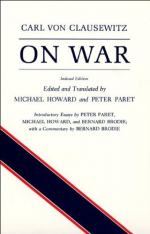
|
| Name: _________________________ | Period: ___________________ |
This quiz consists of 5 multiple choice and 5 short answer questions through Book 3, On Strategy in General : Chapter 2, Force, Reserves & Space.
Multiple Choice Questions
1. What type of operations does Clausewitz say can help in the outcome of war?
(a) Operations of political significance.
(b) Operations to try to capture the capital city of the enemy.
(c) Operations to try to destroy the enemy's army.
(d) Operations to try to occupy more land.
2. What was the "art of war" about according to Clausewitz?
(a) Tactical mastery.
(b) Establishment of an army.
(c) Defeating your enemy in one blow.
(d) Strategic mastery.
3. Why were the rules created according to Clausewitz?
(a) To prevent civilians from interfering with war plans.
(b) To provide guidance on how to behave and act.
(c) To prevent the military from taking power.
(d) To prevent soldiers from revolting.
4. What controls the strategist according to Clausewitz?
(a) The generals.
(b) Duty to the troops and to the objectives.
(c) The civilian powers.
(d) The rules of engagement.
5. What is strategy according to Clausewitz in Book 3, Chapter 1?
(a) The thinking prior to battle.
(b) The setting up of the army.
(c) The use of engagements.
(d) The supply line safety.
Short Answer Questions
1. What effect can physical violence have on troops if they don't understand why violence should be used according to Clausewitz?
2. For Clausewitz, when should defeating the enemy not be the aim of a war?
3. Who does Clausewitz say fares best at war with the consequences of friction?
4. What do allies do concerning weaknesses according to Clausewitz?
5. What does Clausewitz say was setup as a final arbiter of war in the former theory of the "art of war"?
|
This section contains 319 words (approx. 2 pages at 300 words per page) |

|




